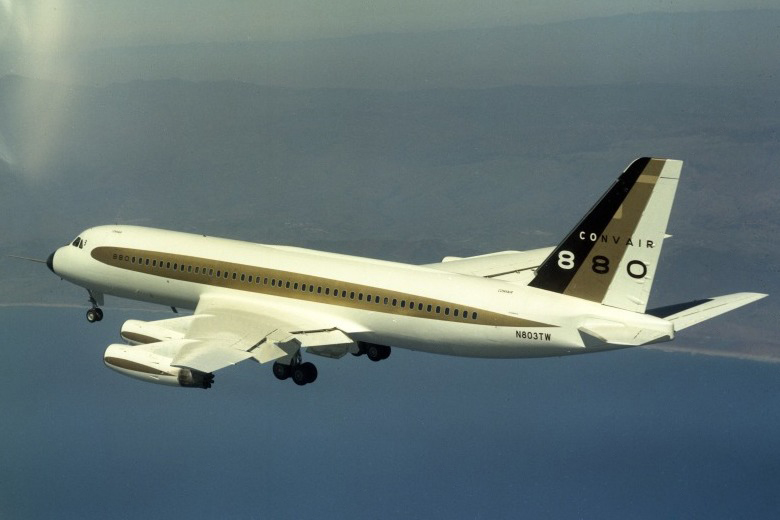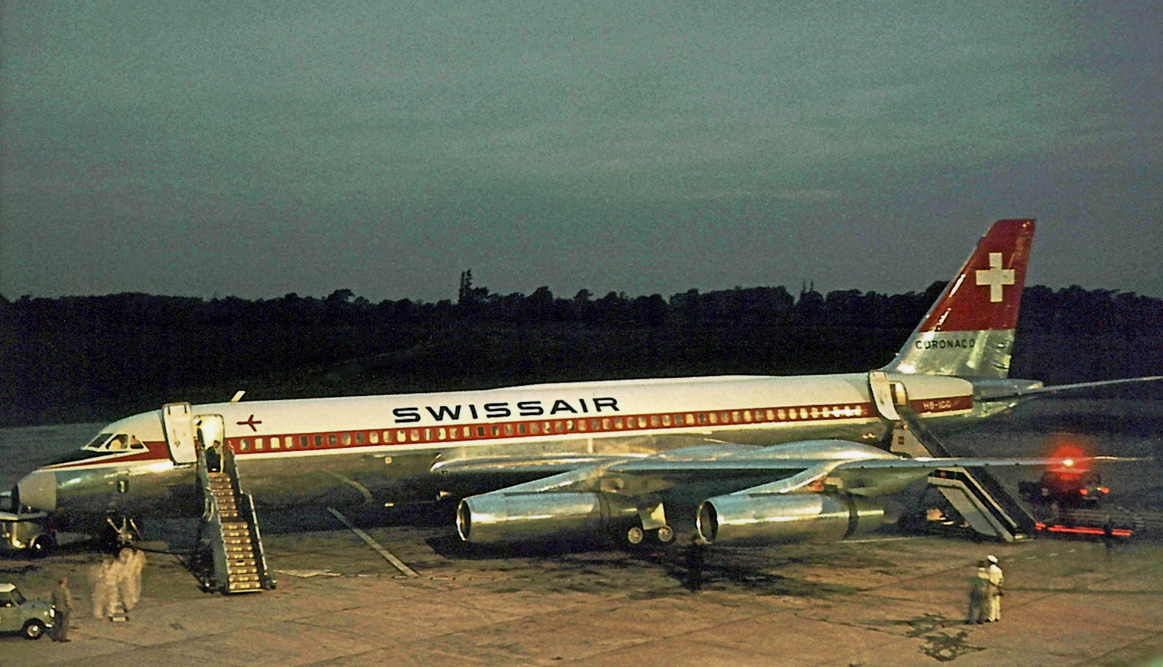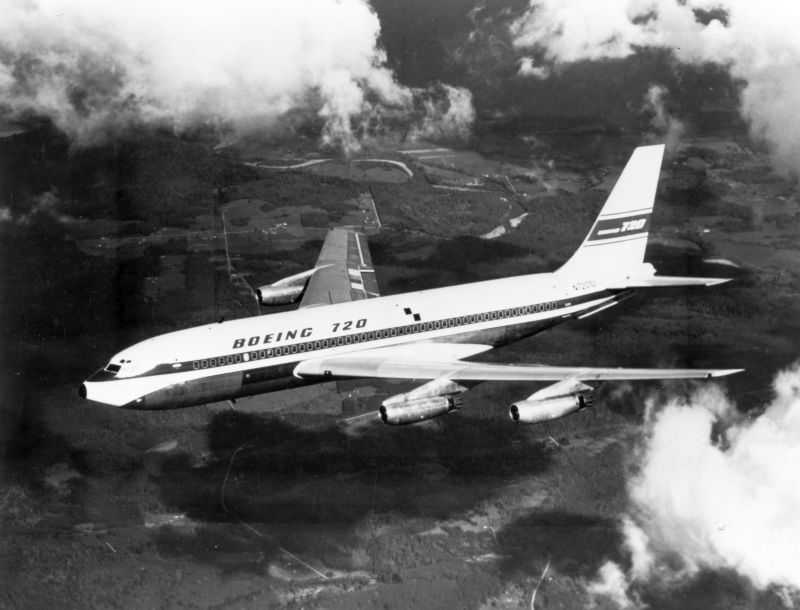|
Convair 880
The Convair 880 is an American narrow-body jet airliner produced by the Convair division of General Dynamics. It was designed to compete with the Boeing 707 and Douglas DC-8 by being smaller but faster, a niche that failed to create demand. When it was first introduced, some in aviation circles claimed that at , it was the fastest jet transport in the world. Only 65 Convair 880s were produced over the lifetime of the production run from 1959 to 1962, and General Dynamics eventually withdrew from the airliner market after considering the 880 project a failure. The Convair 990 Coronado was a stretched and faster variant of the 880. Development Convair began development of a medium-range commercial jet in April 1956, to compete with announced products from Boeing and Douglas. Initially the design was called the Skylark, but the name was later changed to the Golden Arrow, then Convair 600 and then finally the 880, both numbers referring to its top speed of 600 mph (970 k ... [...More Info...] [...Related Items...] OR: [Wikipedia] [Google] [Baidu] |
Narrow-body Aircraft
A narrow-body aircraft or single-aisle aircraft is an airliner arranged along a single aisle, permitting up to 6-abreast seating in a cabin less than in width. In contrast, a wide-body aircraft is a larger airliner usually configured with multiple aisles and a fuselage diameter of more than , allowing at least seven-abreast seating and often more travel classes. Market Historically, beginning in the late 1960s and continuing through the 1990s, twin engine narrow-body aircraft, such as the Boeing 737 Classic, McDonnell-Douglas MD-80 and Airbus A320 were primarily employed in short to medium-haul markets requiring neither the range nor the passenger-carrying capacity of that period's wide-body aircraft. The re-engined B737 MAX and A320neo jets offer 500 miles more range, allowing them to operate the 3,000 miles transatlantic flights between the eastern U.S. and Western Europe, previously dominated by wide-body aircraft. Norwegian Air Shuttle, JetBlue Airways and TAP ... [...More Info...] [...Related Items...] OR: [Wikipedia] [Google] [Baidu] |
McDonnell Douglas
McDonnell Douglas was a major American aerospace manufacturing corporation and defense contractor, formed by the merger of McDonnell Aircraft and the Douglas Aircraft Company in 1967. Between then and its own merger with Boeing in 1997, it produced well-known commercial and military aircraft, such as the DC-10 airliner, the F-15 Eagle air superiority fighter, the MD-80 airliner, and the F/A-18 Hornet multirole fighter. The corporation's headquarters were at St. Louis Lambert International Airport, near St. Louis, Missouri; its subsidiary, McDonnell Douglas Technical Services Company (MDTSC), was based elsewhere in St. Louis County, Missouri. At its peak in mid-1990, McDonnell Douglas employed 132,500 people. By the end of 1992, employment had dropped to approximately 87,400. History Background The company was formed from the firms of James Smith McDonnell and Donald Wills Douglas in 1967. Both men were of Scottish ancestry, were graduates of the Massachusetts Insti ... [...More Info...] [...Related Items...] OR: [Wikipedia] [Google] [Baidu] |
Viasa
Venezolana Internacional de Aviación Sociedad Anónima ( en, JSC Venezuelan International Airways), or VIASA for short, was the Venezuelan flag carrier airline between 1960 and 1997. It was headquartered in the Torre Viasa in Caracas. Launched in , it was nationalised in 1975 due to financial problems, and re- privatised in 1991, with the major stake going to Iberia. The company ceased operations in , and went into liquidation. History Early years Viasa was envisioned by the government of Venezuela in 1959 to create a new company that could serve as the country's flag carrier and run without government intervention. It was set up in 1960 when the international routes operated by Línea Aeropostal Venezolana (LAV) and Avensa were merged and taken over by the newly created carrier. The government contributed with 55% of the capital, while private investors – among which were LAV and Avensa, the latter owned by Grupo Boulton and Pan American World Airways—contributed w ... [...More Info...] [...Related Items...] OR: [Wikipedia] [Google] [Baidu] |
Northeast Airlines
Northeast Airlines was an American airline based in Boston, Massachusetts that chiefly operated in the northeastern United States, and later to Canada, Florida, the Bahamas, Los Angeles and other cities. It was acquired by and merged into Delta Air Lines in August 1972. History The airline began as Boston-Maine Airways, founded as a Pan Am contract carrier on July 20, 1931, by the Boston and Maine Railroad and Maine Central Railroad, flying from Boston to Bangor via Portland. It flew only sporadically until August 11, 1933, when National Airways began to operate its flights under contract. National also operated Central Vermont Airways, a subsidiary of the Central Vermont Railway, and the two carriers together had a network across New England to New Hampshire, Vermont, and Montreal. Amelia Earhart and Eugene Vidal were among the co-founders of National, and Earhart was a prominent salesperson for the airline in its early years. National initially operated Stinson Airline ... [...More Info...] [...Related Items...] OR: [Wikipedia] [Google] [Baidu] |
Cathay Pacific
Cathay Pacific Airways Limited (CPA), more widely known as Cathay Pacific (), is the flag carrier of Hong Kong, with its head office and main hub located at Hong Kong International Airport. The airline's operations and subsidiaries have scheduled passenger and cargo services to over 190 destinations and present in more than 60 countries worldwide including codeshares and joint ventures. Cathay Pacific operates a fleet consisting of Airbus A321, Airbus A321neo, Airbus A330, Airbus A350, and Boeing 777 aircraft. Cathay Pacific Cargo operates two models of the Boeing 747. Defunct wholly owned subsidiary airline Cathay Dragon, which ceased operations in 2020, previously flew to 44 destinations in the Asia-Pacific region from its Hong Kong base. In 2010, Cathay Pacific and Cathay Pacific Cargo, together with Dragonair (then Cathay Dragon), carried nearly 27 million passengers and over 1.8 million tons of cargo and mail. The airline was founded on 24 September 1946 by ... [...More Info...] [...Related Items...] OR: [Wikipedia] [Google] [Baidu] |
Convair 990
The Convair 990 Coronado is an American narrow-body four-engined jet airliner produced between 1961 and 1963 by the Convair division of American company General Dynamics. It was a stretched version of its earlier Convair 880 produced in response to a request from American Airlines: the 990 was lengthened by , which increased the number of passengers from between 88 and 110 in the 880 to between 96 and 121. This was still fewer passengers than the contemporary Boeing 707 (110 to 189) or Douglas DC-8 (105 to 173), although the 990 was faster than either in cruise. Design and development American Airlines asked Convair to design an aircraft for coast-to-coast flights, able to fly nonstop from New York City to Los Angeles against the wind. They wanted a larger passenger capacity than the 880, which was the smallest of the first-generation U.S. jet airliners. It was known as the Convair 600 and was redesignated the Convair 990 in the month of its first flight. The 990 began flight t ... [...More Info...] [...Related Items...] OR: [Wikipedia] [Google] [Baidu] |
Krueger Flap
Krueger flaps, or Krüger flaps, are lift enhancement devices that may be fitted to the leading edge of an aircraft wing. Unlike Leading-edge slat, slats or leading-edge droop flap, droop flaps, the main wing upper surface and its nose is not changed. Instead, a portion of the lower wing is rotated out in front of the main wing leading edge. Several modern aircraft use this design between the fuselage and closest engine, where the wing is thickest. Outboard of the engine, leading-edge slat, slats are used on the leading edge. The Boeing 727 also used a mix of inboard Krueger flaps and outboard slats, although it had no engine between them. Most early jet airliners, such as the Boeing 707 and Boeing 747, used Krueger flaps only. Operation While the aerodynamic effect of Krueger flaps may be similar to that of Leading edge slats, slats or Leading edge slot, slots (in those cases where there is a gap or slot between the flap trailing edge and wing leading edge), they are deployed diff ... [...More Info...] [...Related Items...] OR: [Wikipedia] [Google] [Baidu] |
Pratt & Whitney JT3C
The Pratt & Whitney J57 (company designation: JT3C) is an axial-flow turbojet engine developed by Pratt & Whitney in the early 1950s. The J57 (first run January 1950) was the first 10,000 lbf (45 kN) thrust class engine in the United States. The J57/JT3C was developed into the J52 turbojet, the J75/JT4A turbojet, the JT3D/TF33 turbofan, and the XT57 turboprop (of which only one was built). The J57 and JT3C saw extensive use on fighter jets, jetliners, and bombers for many decades. Design and development The J57 was a development of the Pratt & Whitney XT45 (PT4) turboprop engine that was originally intended for the Boeing XB-52. As the B-52 power requirements grew, the design evolved into a turbojet, the JT3. Pratt & Whitney designed the J57 to have a relatively high overall pressure ratio to help improve both Thrust-specific fuel consumption and specific thrust, but it was known that throttling a single high pressure ratio compressor would cause stability problems. ... [...More Info...] [...Related Items...] OR: [Wikipedia] [Google] [Baidu] |
Thrust Specific Fuel Consumption
Thrust-specific fuel consumption (TSFC) is the fuel efficiency of an engine design with respect to thrust output. TSFC may also be thought of as fuel consumption (grams/second) per unit of thrust (newtons, or N), hence ''thrust-specific''. This figure is inversely proportional to specific impulse, which is the amount of thrust produced per unit fuel consumed. TSFC or SFC for thrust engines (e.g. turbojets, turbofans, ramjets, rockets, etc.) is the mass of fuel needed to provide the net thrust for a given period e.g. lb/(h·lbf) (pounds of fuel per hour-pound of thrust) or g/(s·kN) (grams of fuel per second-kilonewton). Mass of fuel is used, rather than volume (gallons or litres) for the fuel measure, since it is independent of temperature. Specific fuel consumption of air-breathing jet engines at their maximum efficiency is more or less proportional to exhaust speed. The fuel consumption ''per mile'' or ''per kilometre'' is a more appropriate comparison for aircraft that travel a ... [...More Info...] [...Related Items...] OR: [Wikipedia] [Google] [Baidu] |
Boeing 720
The Boeing 720 is an American narrow-body airliner produced by Boeing Commercial Airplanes. Announced in July 1957 as a 707 derivative for shorter flights from shorter runways, the 720 first flew on November 23, 1959. Its type certificate was issued on June 30, 1960, and it entered service with United Airlines on July 5, 1960. A total of 154 Boeing 720s and 720Bs were built until 1967. As a derivative, the 720 had low development costs, allowing profitability despite few sales. Compared to the 707-120, it has a length reduced by 8.33 feet (2.54 m), a modified wing and a lightened airframe for a lower maximum takeoff weight. Originally designed to be powered by four Pratt & Whitney JT3C turbojets, the initial 720 would cover a range with 131 passengers in two classes. The reconfigured 720B, powered by JT3D turbofans, first flew on October 6, 1960, and entered service in March 1961. It could seat 156 passengers in one class over a range. Some 720s were later converted to 720 ... [...More Info...] [...Related Items...] OR: [Wikipedia] [Google] [Baidu] |
Convair 880 Lisa Marie Graceland Memphis TN 2013-04-01 007
Convair, previously Consolidated Vultee, was an American aircraft manufacturing company that later expanded into rockets and spacecraft. The company was formed in 1943 by the merger of Consolidated Aircraft and Vultee Aircraft. In 1953, it was purchased by General Dynamics, and operated as their Convair Division for most of its corporate history. Convair is best known for its military aircraft; it produced aircraft such as the Convair B-36 Peacemaker and Convair B-58 Hustler strategic bombers, and the Convair F-102 Delta Dagger and Convair F-106 Delta Dart interceptors. It also manufactured the first Atlas rockets, including the rockets that were used for the crewed orbital flights of Project Mercury. The company's subsequent Atlas-Centaur design continued this success and derivatives of the design remain in use as of 2020. The company also entered the jet airliner business with its Convair 880 and Convair 990 designs. These were smaller than contemporary aircraft like t ... [...More Info...] [...Related Items...] OR: [Wikipedia] [Google] [Baidu] |








